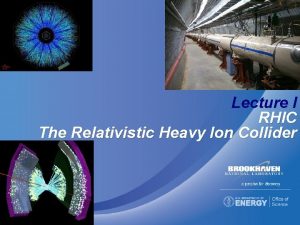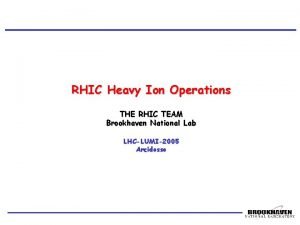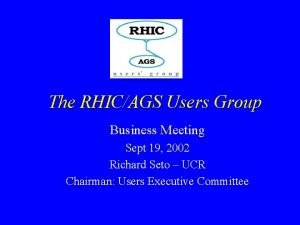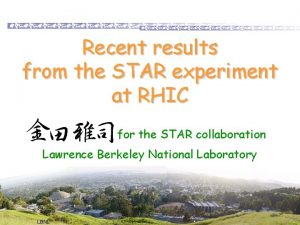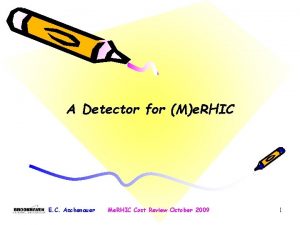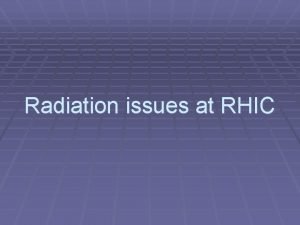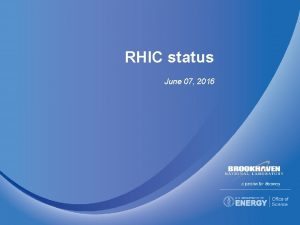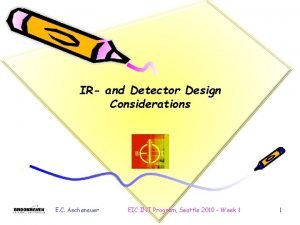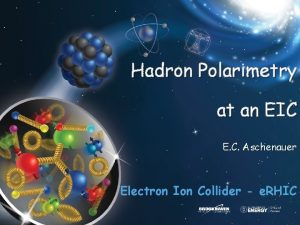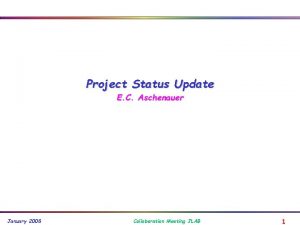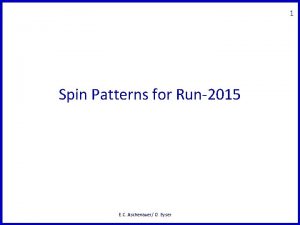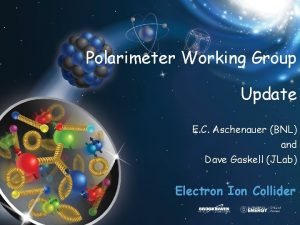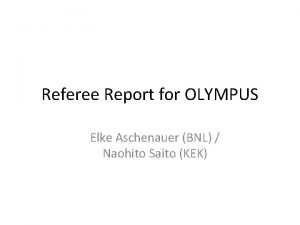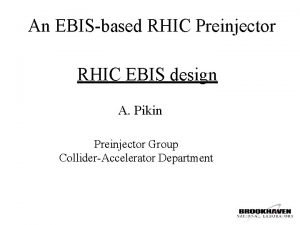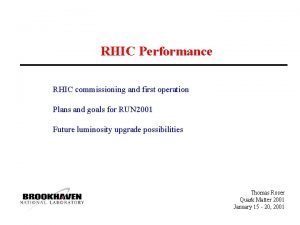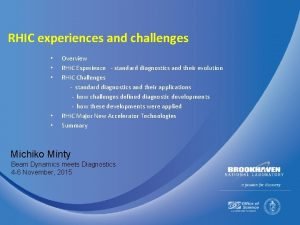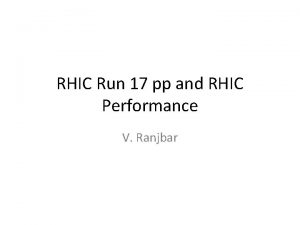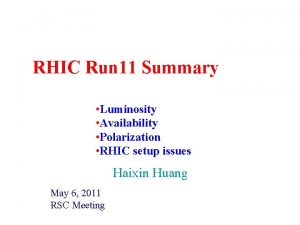A Detector for Me RHIC E C Aschenauer






























- Slides: 30

A Detector for (M)e. RHIC E. C. Aschenauer EIC-IAC @ JLab, November 2009 1

Detector Requirements from Physics q ep-physics Ø the same detector needs to cover inclusive (ep -> e’X), semiinclusive (ep -> e’hadron(s)X) and exclusive (ep -> e’pp) reactions large acceptance absolutely crucial (both mid and forward-rapidity) particle identification is crucial e, p, K, p, n over wide momentum range and scattering angle excellent secondary vertex resolution (charm) particle detection to very low scattering angle around 1 o in e and p/A direction in contradiction to strong focusing quads close to IP Ø small systematic uncertainty for e/p polarization measurements Ø very small systematic uncertainty for luminosity measurement q e. A-physics Ø requirements very similar to ep challenge to tag the struck nucleus in exclusive and diffractive reactions. E. C. Aschenauer EIC-IAC @ JLab, November 2009 2

Event kinematics scattered lepton 20 x 250 D I S 4 x 50 4 x 250 175 o 179 o D I F F R A C T I V E without magnetic field E. C. Aschenauer EIC-IAC @ JLab, November 2009 3

Event kinematics produced hadrons (p+) D I S 4 x 50 20 x 250 4 x 250 D I F F R A C T I V E DIS: small theta important without magnetic field E. C. Aschenauer EIC-IAC @ JLab, November 2009 4

Include: recoil proton plots and update the other ones for better visibility E. C. Aschenauer EIC-IAC @ JLab, November 2009 5

ERL-based e. RHIC Design e. RHIC detector 10 -20 Ge. V e x 325 Ge. V p 130 Ge. V/u Au possibility of 30 Ge. V @ low current operation x 200 m SRF linac (5) Ge. V per pass (4) passes Polarized e-gun IC RH or Me tect de Co e- here co ole nt r Gap 5 mm total 0. 3 T for 30 Ge. V 2 4 5 Beam dump 20 Ge. V e-beam IX EN PH Common vacuum chamber 16 Ge. V e-beam 8 Ge. V e-beam 5 mm STAR E. C. Aschenauer 12 Ge. V e-beam 5 mm EIC-IAC @ JLab, November 2009 4 to 5 vertically separated recirculating passes 6

A Detector for Diffraction Si tr ac ki ng st at io ns Design by Allen Caldwell: p EM Calorimeter 2 x 14 Si tracking stations Hadronic Calorimeter Compact – fits in dipole magnet with inner radius of 80 cm. Long - |z| 5 m e E. C. Aschenauer EIC-IAC @ JLab, November 2009 7

First ideas for a detector concept Solenoid (4 T) Dipol 3 Tm FED // Dipol 3 Tm // FPD ZDC q Dipoles needed to have good forward momentum resolution q q q Ø Solenoid no magnetic field @ r ~ 0 DIRC, RICH hadron identification p, K, p high-threshold Cerenkov fast trigger for scattered lepton JLab, November 2009 E. C. Aschenauer radiation length very critical low EIC-IAC lepton @ energies 8

IR-Design for Me. RHIC I @ IP-2 q no synchrotron shielding included q IP-2: height beam-pipe floor ~6’ (with digging ~10’) E. C. Aschenauer EIC-IAC @ JLab, November 2009 9

Diffractive events include 1 or 2 slides from Matt on diffractive studies for e. A to make the point where the nuclei go, like Thomas slide 19 E. C. Aschenauer EIC-IAC @ JLab, November 2009 10

Detection from hadron beam fragments q Tagging from Au fragments and p/n in ep Ø suppress incoherent scattering / ensure exclusivity neutrons are detected in ZDC protons use magnetic rigidity Au: p 2. 5: 1 Ø DX magnets disturbs p tagging E. C. Aschenauer EIC-IAC @ JLab, November 2009 11

IR-Design for Me. RHIC IP-2 q q q no synchrotron shielding included allows p and heavy ion decay product tagging IP-2: height beam-pipe floor ~6’ (with digging ~10’) E. C. Aschenauer EIC-IAC @ JLab, November 2009 12

First ideas for a detector concept Solenoid (4 T) Dipol 3 Tm FED // Dipol 3 Tm // FPD ZDC q Dipoles needed to have good forward momentum resolution q q q Ø Solenoid no magnetic field @ r ~ 0 DIRC, RICH hadron identification p, K, p high-threshold Cerenkov fast trigger for scattered lepton JLab, November 2009 E. C. Aschenauer radiation length very critical low EIC-IAC lepton @ energies 13

Basis for Detector design explain the basis for the detector design, like dirc copy of Babar …. E. C. Aschenauer EIC-IAC @ JLab, November 2009 14

Me. RHIC Detector in Geant-3 central tracking ala Ba. Bar Silicon Strip detector Drift Chambers q no hadronic calorimeter in barrel, because of vertical space @ IP-2 E. C. Aschenauer EIC-IAC @ JLab, November 2009 15

Me. RHIC Detector in Geant-3 E. C. Aschenauer EIC-IAC @ JLab, November 2009 16

Me. RHIC Detector in Geant-3 E. C. Aschenauer EIC-IAC @ JLab, November 2009 17

Summary q Have done first steps on a detector design q Optimizations needed Ø magnetic fields do we need 4 T for solenoid and 3 Tm for dipole Ø what radiation length can we tolerate @ low e’ momentum Ø optimize distance Dipole to Solenoid Ø impact of beam lines through the detector on physics need to optimize acceptance at low scattering angle need acceptance down to 1 o Ø need to include lepton polarimeter in IR design Ø need to include luminosity monitor into IR design E. C. Aschenauer EIC-IAC @ JLab, November 2009 18

Start immediately at 12 o’clock Detector cost savings have Me. RHIC-detector @ IP-12 fully staged detector from Me. RHIC to e. RHIC vertical space much bigger need to buy magnets only once can stage detector components, i. e. hadronic calorimeter no moving of components only advantages E. C. Aschenauer EIC-IAC @ JLab, November 2009 19

12: 00 experimental area E. C. Aschenauer EIC-IAC @ JLab, November 2009 20

Work done @ JLAB E. C. Aschenauer EIC-IAC @ JLab, November 2009 21

ELIC Detector/IR Layout solenoid ion FFQs dipole bending scattered protons “up” ions electrons IP with crossing angle electron FFQs Distance from IP to electron FFQ: 6 m to ion FFQ: 9 m Electron FF quad Distance from IP length Field strength Beam size sx sy @ 3 Ge. V Quad 1 6. 0 meter 50 cm -1. 14 k. G/cm 5 mm 4 mm Quad 2 6. 75 meter 120 cm 0. 71 k. G/cm 8 mm 3 mm Quad 3 8. 7 meter -0. 75 k. G/cm 4 mm 50 cm Modest electron final focusing quad field requirements quads can be made small E. C. Aschenauer EIC-IAC @ JLab, November 2009 22

ELIC detector cartoon - Oct. 09 8 meters (for scale) Offset IP? 140 degrees TOF HCAL ECAL Tracking HTCC DIRC RICH dipole solenoid Ion beam Additional electron detection (tracking, calorimetry) for low. EIC-IAC @ JLab, November 2009 2 physics Aschenauer QE. C. not on cartoon 1 st (small) electron FF quad @ 6 m e beam 23

ELIC Detector Magnetic Field q Central 4 T solenoid with 5 meter length and 4 meter ID Ø Need to add good particle identification detectors up to 40 Ø Ø Ø degrees on ion side drives large ID to keep this area “open” 4 T field renders O(1%) or better momentum resolution for particles with momentum < 10 Ge. V (and angles > 40 degrees) q Optimize detector to detect particles down to (at least) one degrees Ø Add 2 -3 Tm dipole field to improve momentum resolution at Ø forward angles. Ø Two solutions: add dipole, or add dipole to solenoid? Ø Can in principle also have split dipole, with different polarity Ø before/after IP, if this helps accelerator design. 5 T solenoid with 0. 6 T dipole winding: Integrated transverse (By) field strength @ 90 degrees 10. 9 Tm @ 40 degrees 15. 3 Tm @ 1 degree 1. 4 Tm àMay present alternate solution if space is at a premium & 1. 4 Tm sufficient field strength at 1 o. à Note: all configurations iron free at moment Dipole coils E. C. Aschenauer EIC-IAC @ JLab, November 2009 24

Recoil Tagging in Deeply Virtual Exclusive Reactions on Nuclei e + AZ + ( , , J/ ) Determining exclusivity requires tagging the nucleus in the final state. The typical scale of transverse momentum transfer is given by the rms nuclear radius. (for nuclei from 4 He to 20 Ne, k' k q' q ZP Mm ZP' this scale ranges from 125 Me. V/c to 75 Me. V/c) For Nuclei ≥ 4 He, the recoil nucleus is – INSIDE the transverse admittance of the FF Quads • Qms ≈ 1 mr PA, transverse ≈ Z·(60 Me. V/c) (for 60 Ge. V ion beam) • Beam spread is larger than 1/RA scale for nuclear imaging. • Z·(60 Me. V/c ) > (0. 2 Ge. V/c)/A 1/3 (≥ 75 Me. V/c for AZ< 20 Ne) – OUTSIDE the longitudinal admittance of the ring lattice!!! The nuclei may be detectable at high resolution with far forward tracking in the lattice by having large dispersion ELIC study E. C. Aschenauer EIC-IAC @ JLab, November 2009 25

Far Forward Ion Tagging at (60 Ge. V/c) Z q Sample optics at token Roman Pot Telescope position Ø Ø ELIC typical: Dispersion D = 1 m, Beta function b* = 2 m ELIC typical: (x, Q) = (250 mm, 125 mr) rms Use a 10 sx Beam Stay Clear (BSC) distance 2. 5 mm Ions are detectable for |d. PA||/PA| > BSC/D = 2. 5 x 10 -3. Skewness 2 z (~x/A) of Deep Virtual reaction = long. momentum fraction of a nucleon in projectile ion. Skewness acceptance: 2 z > (2. 5 x 10 -3)A 0. 05 for 20 Ne. q Assumption: 1 m drift with 100 mm spatial resolution Ø d. Q = 100 mr equal to beam Qrms. Ø PA’ Momentum Resolution = sx/D = 2. 5 x 10 -4. D|| = (k-k’-q’) || = (PA’-PA’)|| s(D||) = (4 x 10 -4)(30 Ge. V/c) A = (12 Me. V/c) A Ø Exclusivity constraint D 2 = 2 MA (PA’-PA) q Using ELIC arc as spectrometer to a longitudinal momentum transfer resolution of 10 -4 by increasing dispersion @ IR will be explored in more detail E. C. Aschenauer EIC-IAC @ JLab, November 2009 26

BACKUP E. C. Aschenauer EIC-IAC @ JLab, November 2009 27

Zeus @ HERA I E. C. Aschenauer EIC-IAC @ JLab, November 2009 28

Zeus @ HERA II E. C. Aschenauer EIC-IAC @ JLab, November 2009 29

Hera I vs Hera II Focusing Quads close to IP Problem forward acceptance E. C. Aschenauer EIC-IAC @ JLab, November 2009 30
 Orbital revolution
Orbital revolution Rhic brookhaven
Rhic brookhaven Rhic ags users meeting 2020
Rhic ags users meeting 2020 Rhic
Rhic Myndigheten för delaktighet
Myndigheten för delaktighet Presentera för publik crossboss
Presentera för publik crossboss Vad är densitet
Vad är densitet Debattartikel struktur
Debattartikel struktur Kung dog 1611
Kung dog 1611 Nationell inriktning för artificiell intelligens
Nationell inriktning för artificiell intelligens Tack för att ni har lyssnat
Tack för att ni har lyssnat Tobinskatten för och nackdelar
Tobinskatten för och nackdelar Vad är referatmarkeringar
Vad är referatmarkeringar Mjälthilus
Mjälthilus Byggprocessen steg för steg
Byggprocessen steg för steg Frger
Frger Vätsketryck formel
Vätsketryck formel Vilka tal pekar pilarna på
Vilka tal pekar pilarna på Rbk-mätning
Rbk-mätning Elektronik för barn
Elektronik för barn Underlag för särskild löneskatt på pensionskostnader
Underlag för särskild löneskatt på pensionskostnader Borra hål för knoppar
Borra hål för knoppar Smärtskolan kunskap för livet
Smärtskolan kunskap för livet Bris för vuxna
Bris för vuxna Trög för kemist
Trög för kemist Argument för teckenspråk som minoritetsspråk
Argument för teckenspråk som minoritetsspråk Indikation för kejsarsnitt på moderns önskan
Indikation för kejsarsnitt på moderns önskan Datorkunskap för nybörjare
Datorkunskap för nybörjare Delegerande ledarskap
Delegerande ledarskap Toppslätskivling effekt
Toppslätskivling effekt Ekologiskt fotavtryck
Ekologiskt fotavtryck
